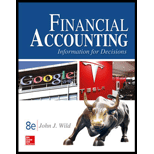
1
Introduction: Percentage representation of cash in terms of current assets and total assets is used to identify the immediate availability of liquidity in the organization. The percentage representation of cash in terms of current liabilities is to identify the immediate pay off of liabilities available in the organization.
To Determine: Percentage that cash represents of current assets, total assets, current liabilities and shareholder equity for each year
1
Answer to Problem 9BTN
| Particulars | Current Year | Prior Year |
| Cash that represents current assets | 14.6% | 14.7% |
| Cash that represents total assets | 7.3% | 7.6% |
| Cash that represents current Liabilities | 32.4% | 31.7% |
| Cash that represents Shareholders’ Equity | 10.0% | 10.8% |
Explanation of Solution
Computation of percentage that cash represents of current assets, total assets, current liability and shareholders’ equity.
a. Cash that represents current assets =
b. Cash that represents total assets =
c. Cash that represents current liabilities =
d. Cash that represents Shareholders Equity =
| Particulars | Current Year | Prior Year |
| Cash | ₩16,840,766 | ₩16,284,780 |
| Current Assets | ₩115,146,026 | ₩110,760,271 |
| Cash that represents current assets |
|
|
| Answer | 14.6% | 14.7% |
| Total Assets | ₩230,422,958 | ₩214,075,018 |
| Cash that represents total assets |
|
|
| Answer | 7.3% | 7.6% |
| Current Liabilities | ₩52,013,913 | ₩51,315,409 |
| Cash that represents current Liabilities |
|
|
| Answer | 32.4% | 31.7% |
| Shareholders’ Equity | ₩168,088,188 | ₩150,016,010 |
| Cash that represents Shareholders’ Equity |
|
|
| Answer | 10.0% | 10.8% |
Comment on the trend of the percentage
From the above table, the conclusion can be drawn that there is no major change in the percentage that represents the current assets, total assets, current liabilities and shareholders’ Equity.
2
Introduction: To identify the difference between the cash balance of current and prior year, whether there has been an increase or decrease in the cash balance the percentage is calculated taking the prior year as the base.
To Determine:Percentage change in current and prior year cash balances
2
Answer to Problem 9BTN
Therefore, percentage change in cash balance is 3.4%.
Explanation of Solution
Percentage change in current and prior year cash balances Difference in cash Balance of current and previous year =₩16,840,766-₩16,284,780
= ₩555,986
Percentage change in cash balance =
= 3.4%
3
Introduction: Days of Sales uncollected is calculated to identify the time by
To Determine: Days Sales uncollected at the end of both the current and the prior year.
3
Answer to Problem 9BTN
Days Sales uncollected for current year is 50 days.
Days Sales uncollected of Prior year is 45 days, approx.
Explanation of Solution
Days Sales uncollected at the end of both the current and the prior year.
Days Sales uncollected is calculated by using formula =
Days Sales uncollected for current year =
= 50 days
Days Sales uncollected of Prior year =
= 44.5 days
The day’s sales uncollected has increased by 5.5 days approximately. There has been an increase in accounts receivable but net sales have declined from the previous year. So there has been no improvement in the number of days’ sales uncollected.
Want to see more full solutions like this?
Chapter 6 Solutions
Financial Accounting: Information for Decisions
- The actual cost of direct labor per hour is $16.25 and the standard cost of direct labor per hour is $15.00. The direct labor hours allowed per finished unit is 0.60 hours. During the current period, 4,500 units of finished goods were produced using 2,900 direct labor hours. How much is the direct labor rate variance? A. $3,625 favorable B. $3,625 unfavorable C. $4,350 favorable D. $4,350 unfavorablearrow_forwardOn January 1 of the current year, Piper Company issues a 4-year, non-interest-bearing note with a face value of $8,000 and receives $4,952 in exchange. The recording of the issuance of the note includes a: a. credit to Notes Payable for $4,952. b. credit to Discount on Notes Payable for $3,048. c. debit to Discount on Notes Payable for $3,048. d. debit to Cash for $8,000.arrow_forwardPLease helparrow_forward
- What is the budgeted total cost of direct materials purchases?arrow_forwardHy expert provide answer with calculationarrow_forwardDuring September, the assembly department completed 10,500 units of a product that had a standard materials cost of 3.0 square feet per unit at $2.40 per square foot. The actual materials purchased consisted of 22,000 square feet at $2.60 per square foot, for a total cost of $57,200. The actual material used during this period was 25,500 square feet. Compute the materials price variance and materials usage variance.arrow_forward
- Bluesy Electronics recorded the following financial data: Net Sales $720,500 Average Inventory at Cost = $80,200 Gross Margin Percentage = 42% Calculate the GMROI.arrow_forwardNeed help this question solutionarrow_forwardXYZ Company has a gross profit margin of 0.30, an operating profit margin of 18%, a total asset turnover ratio of 2.0x, and cost of goods sold of $700,000. The company's tax rate is 35%, and it has no debt. Calculate XYZ Company's Return on Assets (ROA).arrow_forward
 Financial And Managerial AccountingAccountingISBN:9781337902663Author:WARREN, Carl S.Publisher:Cengage Learning,Principles of Accounting Volume 1AccountingISBN:9781947172685Author:OpenStaxPublisher:OpenStax College
Financial And Managerial AccountingAccountingISBN:9781337902663Author:WARREN, Carl S.Publisher:Cengage Learning,Principles of Accounting Volume 1AccountingISBN:9781947172685Author:OpenStaxPublisher:OpenStax College Managerial Accounting: The Cornerstone of Busines...AccountingISBN:9781337115773Author:Maryanne M. Mowen, Don R. Hansen, Dan L. HeitgerPublisher:Cengage Learning
Managerial Accounting: The Cornerstone of Busines...AccountingISBN:9781337115773Author:Maryanne M. Mowen, Don R. Hansen, Dan L. HeitgerPublisher:Cengage Learning EBK CONTEMPORARY FINANCIAL MANAGEMENTFinanceISBN:9781337514835Author:MOYERPublisher:CENGAGE LEARNING - CONSIGNMENT
EBK CONTEMPORARY FINANCIAL MANAGEMENTFinanceISBN:9781337514835Author:MOYERPublisher:CENGAGE LEARNING - CONSIGNMENT Financial AccountingAccountingISBN:9781305088436Author:Carl Warren, Jim Reeve, Jonathan DuchacPublisher:Cengage Learning
Financial AccountingAccountingISBN:9781305088436Author:Carl Warren, Jim Reeve, Jonathan DuchacPublisher:Cengage Learning Financial AccountingAccountingISBN:9781337272124Author:Carl Warren, James M. Reeve, Jonathan DuchacPublisher:Cengage Learning
Financial AccountingAccountingISBN:9781337272124Author:Carl Warren, James M. Reeve, Jonathan DuchacPublisher:Cengage Learning





